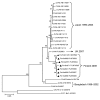Coxsackievirus A6 and hand, foot, and mouth disease, Finland
- PMID: 19788821
- PMCID: PMC2819858
- DOI: 10.3201/eid1509.090438
Coxsackievirus A6 and hand, foot, and mouth disease, Finland
Abstract
During fall 2008, an outbreak of hand, foot, and mouth disease (HFMD) with onychomadesis (nail shedding) as a common feature occurred in Finland. We identified an unusual enterovirus type, coxsackievirus A6 (CVA6), as the causative agent. CVA6 infections may be emerging as a new and major cause of epidemic HFMD.
Figures


References
-
- Cabral LA, Almeida JD, de Oliveira ML, Meza AC. Hand, foot, and mouth disease case report. Quintessence Int. 1998;29:194–6. - PubMed
MeSH terms
Substances
LinkOut - more resources
Full Text Sources
